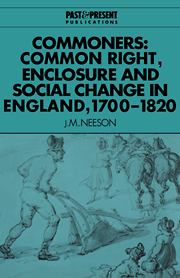Book contents
- Frontmatter
- Contents
- List of tables
- Preface
- Introduction
- 1 The question of value
- I SURVIVAL
- II DECLINE
- 7 Two villages
- 8 Decline and disappearance
- 9 Resisting enclosure
- III CONCLUSION
- Appendix A Using the Land Tax
- Appendix B Acreage equivalents
- Appendix C Correcting and editing the Land Tax
- Appendix D Landholding estimates
- Bibliography
- Index
- Past and Present Publications
8 - Decline and disappearance
Published online by Cambridge University Press: 01 February 2010
- Frontmatter
- Contents
- List of tables
- Preface
- Introduction
- 1 The question of value
- I SURVIVAL
- II DECLINE
- 7 Two villages
- 8 Decline and disappearance
- 9 Resisting enclosure
- III CONCLUSION
- Appendix A Using the Land Tax
- Appendix B Acreage equivalents
- Appendix C Correcting and editing the Land Tax
- Appendix D Landholding estimates
- Bibliography
- Index
- Past and Present Publications
Summary
Allow me first to consider a little the case of the Poor under inclosures. They feel the evil, and complain; but complain in vain. The common people, indeed, frequently murmur without cause; they quote Scripture improperly. Yet, my Lord, interdum vulgus rectum videt: and Scripture may be aptly adduced against this unchristian practice. It is not doing as we would be done unto: it is not loving our neighbour as ourselves; but is removing his landmark, contrary to his inclination; and there-fore joining field to field by iniquity. The history of Ahab and Naboth is not altogether inapplicable here. It does not appear from the sacred pages, that the wicked prince intended to rob his subject of his vineyard; but to make him, as he supposed, a proper recompence. Under an act of parliament, the poor man's land is frequently taken from him; and what is allotted to him is by no means a compensation for his loss.
Anon., Reflections on the Cruelty of Inclosing … letter to the Bishop of Lincoln (1796), pp. 6–7In an important article published in 1979, J. M. Martin described changes in landholding taking place at parliamentary enclosure in Warwickshire. Like Michael Turner, who had made a similar discovery in Buckinghamshire, Martin was struck by the ‘turnover’, or replacement through land sales, of one set of small landowners by another. However, unlike Turner, he also found that both the engrossing of estates and an absolute numerical decline of small owners followed enclosure, and child mortality rates rose too. This was evidence of a more serious and far-reaching change than ‘turnover’ alone suggested.
- Type
- Chapter
- Information
- CommonersCommon Right, Enclosure and Social Change in England, 1700–1820, pp. 221 - 258Publisher: Cambridge University PressPrint publication year: 1993

